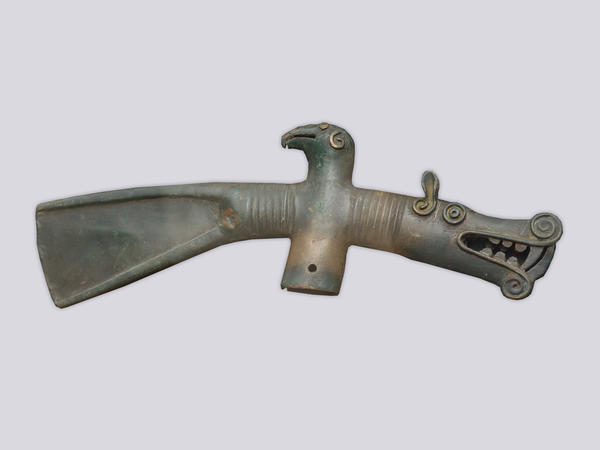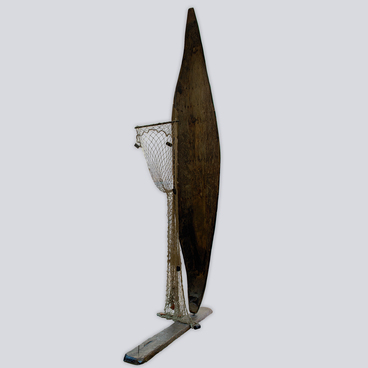In the 6th to 4th centuries BC, the lands stretching along the Volga and Kama Rivers housed various tribes who settled down in the area. The sedentary life style facilitated a more comfortable housekeeping, surface construction, trade, and the development of new crafts.
Pole axe, zoomorphic
Время создания
late 6th to 4th century BC. Early Iron Age, Ananyin culture
Размер
10,3x33 cm
10.3х33х2.07 cm
10.3х33х2.07 cm
Техника
bronze, lost-wax custing
Выставка
4
Открыть в приложении#1
Pole axe, zoomorphic
#6
#7
The Ananyin pole axe on the display dates back to the Iron Age. It is cast in tin bronze with higher concentration of lead and arsenic. In the Upper Kama River area that material was imported and hence, expensive. The ritual objects were commonly made from copper. Ancient masters managed to give that pole axe a neat and precise shape and make it highly durable, which indicates that the natives of the Upper Kama River lands already used special metal processing technologies and skills.
#8
This pole axe is a small axe with a flat tapered wedge and ornately shaped head decorated with cabled fluting of 6 and 7 rolls on the sides. Even in more than 20 centuries, the embossed heads of chthonic predators could be seen in minutest detail.
The images of chthonic beasts represented typical ornament of ceremonial pole axes. In the mythology and beliefs of ancient peoples such monsters served as a reminder of the power of nature and the might of the other world. The heads of bears and griffons often decorated important and status symbols.
#9
In the faith of ancient peoples, the animal heads on the weapon displayed here symbolized the realms of heaven and underworld, and the space between them, the realm of earth. A man who took such pole axe in his hand by the wooden pole acquired special strength and even power over those three realms.
#10
The blade of the weapon on display was deliberately left blunt. Researchers believe that it was intended for various religious ceremonies rather than close battle. Such pole axes also showed their masters’ social status.
#5
Archeologists frequently found such items in wealthy burial grounds. Therefore, researchers concluded that the owner of that specimen was an aristocrat or a chieftain. It could also be a priest who could use such ceremonial weapon to demonstrate his special status or even his power over the souls of his tribesmen.
#11
National Museum of the Republic of Tatarstan
читать дальшескрыть
00:00
00:00
1x
Pole axe, zoomorphic
Время создания
late 6th to 4th century BC. Early Iron Age, Ananyin culture
Размер
10,3x33 cm
10.3х33х2.07 cm
10.3х33х2.07 cm
Техника
bronze, lost-wax custing
Выставка
4
Открыть в приложении
Поделиться



